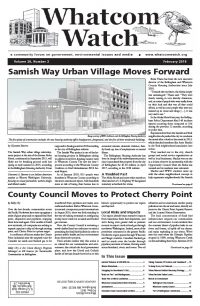by Lorraine Loomis
A recent Washington Supreme Court ruling has strengthened a state law aimed at protecting the waters, shorelines and streambanks essential to salmon recovery. The ruling also reflects the U.S. Supreme Court ruling in the culvert case that the state has a duty to protect habitat so that salmon are available for tribes to exercise our treaty rights.
Since 1943 the Hydraulic Project Approval process — administered by the Washington Department of Fish and Wildlife — has been one of our frontline defenses to protect salmon. An HPA is required for any activities in and around state waters that can threaten fish, shellfish and other natural resources. That includes everything from construction of a hydroelectric dam to maintenance on a private dock.
Most state natural resources agencies that issue permits can use civil law enforcement tools like high fines and stop work orders to ensure compliance. WDFW could only levy a $100 dollar per day fine and could not issue stop work orders. The agency could use criminal law enforcement tools like referring violators to local prosecutors, but clogged courts made convictions slow and difficult.
WDFW wanted to use additional civil enforcement tools like providing technical assistance before moving on to fines, stop work orders and criminal prosecution. It was clear that changes were needed.
In 2011 WDFW embarked on a nearly four-year process to amend the HPA rules that included gathering extensive input from the public, construction industry, local governments, tribes, environmental groups and others.
The process quickly turned into a debate over HPA permit fees, program jurisdiction and enforcement. Several bills were introduced in the state legislature to resolve the conflicts but went nowhere.
One of the largest sticking points was the scope of WDFW’s enforcement authority. Critics claimed the agency could regulate activities only below the high water mark along streams and marine shorelines. Supporters argued that few projects take place entirely below the high water line and can dramatically affect streamflows, water quality and fish.
Opponents filed suit in Thurston County Superior Court challenging WDFW’s jurisdiction, but the court ruled that the agency’s existing area of responsibility was clear. State Attorney General Bob Ferguson came to the same conclusion when asked to issue an opinion in the case.
Dissatisfied, opponents took the case to the Washington Supreme Court, which ruled unanimously in early December that the plain language of the HPA law clearly does not limit WDFW authority above the high water line.
That’s a win for salmon at a time when salmon are declining because we are losing salmon habitat faster than it can be restored and protected.
Healthy streambanks help keep water temperatures low, stabilize sediment and contribute to diverse instream habitat that salmon — both hatchery and wild — need to thrive. Our marine shorelines provide critical habitat for prey species like sand lance that salmon feed on.
Protecting and preserving habitat gains are essential to salmon recovery. The ruling helps ensure that completed habitat restoration projects aren’t undermined by construction or other activities above the highwater mark.
We applaud the Washington Supreme Court’s decision because we believe that all natural resources are connected and that we are connected to them. Limiting how and where those resources can be protected compromises their health and our ability to manage them effectively in the future.
______________________________
Lorraine Loomis is chair of the Northwest Indian Fisheries Com-mission, www.nwifc.org.





























